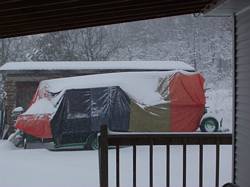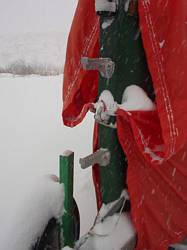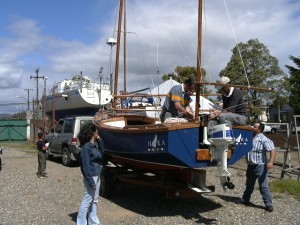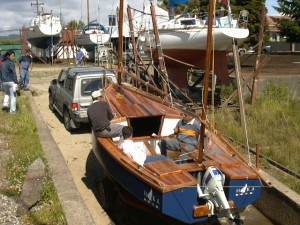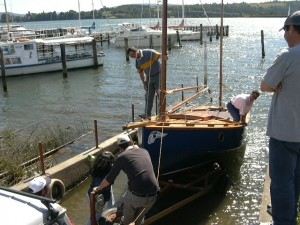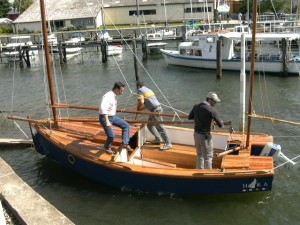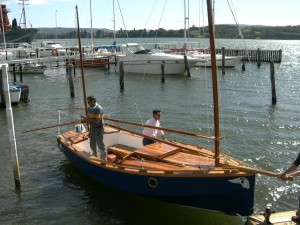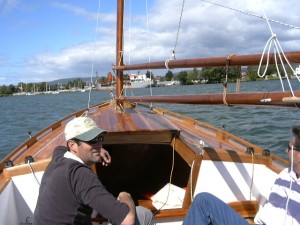Icebreaking – Richard Spelling
Well, woke up this morning, and there is six inches of snow on the ground. Guess that’s a sign I need to publish this issue!
Been kind of quite around here. Send pictures! Send stories! In particular, I know of one long cruise in the Chebacco “Samantha”… Send write up!Well, woke up this morning, and there is six inches of snow on the ground. Guess that’s a sign I need to publish this issue!
In this issue we have an update to “Chebacco Sailing 101, from the previous authors, some miscellaneous conversations, and some pictures of a Chebacco from Down South. Not “Down Under”, but South America! He even wrote me in spanish.
Coincidentally, I’m learning spanish, so I wrote him back in the same language. I’ll spare the regular readers the trails of automatic translation websites… (which translate “sailboat” to “boat of candles”…) I had originally planned on doing the whole issue in his native language, but I’ll do it in
english instead.
Ed Heins reports progress:
As does Mike Haskel:
Good morning Richard,
How are things going down in Oklahoma? I have attached a URL that describes
the building of “Two Grumpy Old Men”
http://www.adventurequest-usa.com/New_Folder/chebacco.htm
All the best,
Mike Haskell, Founder/CEO
Adventure Quest-USA
8 River Road
Bowdoinham, ME 04008
207-666-8976
Also had an interesting conversation on the origins of the name “Chebacco” with Edson White:
—– Original Message —–
—– Original Message —–From: Edson WhiteSent: Tuesday, January 14, 2003 8:30 AMSubject: Where did the name “Chebacco” originate?Richard: I am a little curious. I have password “chebacco”, and my son has “Chebacco-2” Our “clam shack” on the ocean was named “Chebacco” back in the 1800’s!Thus, (1) “Chebacco” is an Indian name, given to a river before the advent of the white man – at least up here in the northeast.Is this also an Indian name prevalent in Oklahoma, and if so, do you know the meaning of the name?Best regards, Edson F. White
I’ve been able to sneak out a couple of times, weather permitting, and using nice tall rubber boots to retrieve the boat from the frigid water. Nothing really notable, except for the icebreaker session!
A friend of mine had come up to deliver half a boat, which is a whole other story. Part of the price was a sailing trip in Schroedinger. Luckily, the weather cooperated, and we had wind and temps in the 45 degree range.
We see some nice waves when we drive over the dam to launch the boat at the local state park, so I’m anticipating a nice brisk sail.
I setup the boat and we launch at the ramp, with only one other vehicle in the state park on this nippy January morning.
The new steps I cast for the boat work great! They make it very easy to get in when the bow is on the beach. (I’ve been doing machine work lately, when it’s to cold to sail.http://www.richardspelling.com/richardsfoundry/ )
I notice the water is calm in the bay where we are launching, I attribute this to the surrounding hills.
As I’m reversing away from the ramp, I idly wonder aloud what that filthy layer of scum is on top of the still water. “Oh, that’s ice” says my sailing
guest.
And I’m about five feet away, backing the transom and the expensive motor right towards it!
Can you say “quick turn”?
I take a good look, and guess what, there is NO WAY out from the launch ramp facility! There’s open, ice free water about 1/4 mile away, but there is no path to get to it!
Nothing for it but to put the 1/8″ stainless steel keel armor to the test. RAMMING SPEED! All hands brace for impact! Crunch!
About this time I’m wishing I had brought the camera!
At about half throttle, the keel rides up on top of the ice, and the weight of the boat breaks the ice, in true icebreaker fashion.
My greatest worry at this point is that I’m going to have to repaint the bottom!
We crunch through the 1/4″ mile of 1/2″ thick ice to open water, and have a nice sail. The only other homemade boat on the lake was out, so we sailed over to him and had a nice chat.
And guess what, when we retrieved the boat, we had to do the whole icebreaker thing again! Oh, my poor paint!
When I got off the boat at the ramp and looked at the hull, there was not a single scratch in the “deck paint” on the hull! Amazing, I was expecting at least bare fiberglass.
And interestingly enough, when I posted my tale on the Bolger egroup, two other people had ice stories, for the same day! We decided to officially dub that saturday “National Bolger Icebreaker and Porch Paint appreciation day”!
More when the weather warms up!
– Chebacco Richard
Mr. Richard
Chebacco Sudamericano
A finales de Diciembre lancé mi bote (Chebacco con un toque de Goland
Gaffer) llamado Haka a las aguas en Valdivia, Chile (no es el fin del
mundo pero de aquí se puede ver). Hasta ahora no he tenido problemas.
Espero enviar pronto fotos navegando a toda Vela.
Saludos
Gustavo Estévez F. (gef@telsur.cl)
Sudamerican Chebacco
At the end of December I launched my boat (a Chebacco with a touch of Goland
Gaffer), called Haka, in the waters of Valdivia, Chile (it is not the end
of the world, but you can see it from here). So far I have not had
any problems. I hope that soon I can send you photos of the boat sailing under full sail.
Greetings
Gustavo Estévez F. ( gef@telsur.cl)
***
Pre-Christmas Sail – Jamie Orr
‘twas the weekend before Christmas…
And after thinking about sailing all week, I decided to go and do it, so on Sunday morning I threw all the warm clothes I own into the boat and headed for the launch ramp.
I drove to Cattle Point, on Victoria’s east shore – Victoria is right on the southeast corner of Vancouver Island – where there are two ramps. The older one is narrow, with rocky sides, and faces northeast, while the newer one faces southeast. Neither has very good provision for mooring the boat while you park or retrieve your trailer, but the new ramp has more room. Because I’d packed up in a hurry last time, I spent a leisurely 40 minutes untangling lines and rigging up. Cattle Point gets a lot of walkers, so I had several conversations as people stopped to ask about the boat.
The launch went smoothly, and Honda fired on the second pull – not bad since he hadn’t been running for a month or so. I motored out until I was clear of the rocks, and had some room to drift, then put up the sails. There was a nice little breeze from the northeast, and Wayward Lass moved along well. I wanted to explore the Chatham and Discovery Islands group, so I tacked upwind, thinking to have the wind behind me to avoid having to tack in the narrow channels between the islands. It took a while to reach the north end of the passage I had chosen, and I was getting hungry, so I picked an inviting bay off the chart, and headed for that. As I worked my way to the head of the bay, a group of kayakers came by, adding some colour to an otherwise wintry scene.
I anchored in about five feet. There was a smooth beach only a few yards away, but most of these islands are Indian Reserve land, and landing is only permitted on the south shore of the most southern, Discovery Island, where a marine park fills that side. Just as well, really, or these islands would be fully developed as well as private, being so close to Victoria. As it was, it was like being miles from civilization, as I watched an otter catching and eating his lunch while mine heated on the stove!
After I’d finished and tidied up, I pulled up the anchor and set the main again. I made sure the anchor was ready if wanted, since I expected some current and the wind was very light by now. I set off south through the passage between the two larger Chatham Islands, with the wind behind me and against the current. The deep channel is close beside the eastern island, which may be why the wind became very light and fluky – the island sheltered the channel too well! I found myself still sailing gently about half way through, but no longer moving in relation to the land. I used the canoe paddle for an extra boost until a gust came along to help, but it was all undone in the end. After another spell of motionless activity, what little wind I had reversed itself, and I had to follow suit.
The current carried me back almost to the north end, where the “real” wind was still coming from the northeast. It seemed to be a little stronger than before, so I turned to try again. This time I stayed further from the shore, despite the shallow areas, and did a little better. I managed to sail past my previous turning point before I had to resort to the paddle. After another 40 or 50 yards, the wind took pity on me and came back.
I thought I was clear then, but found I couldn’t quite sail the course I needed to stay out of the shoals. The current was still running, and the wind was still too light to allow much manoeuvring, so I decided to trust to our shallow draft, and turned inside a pair of rocks that were just ahead. I wondered if this was really a good idea, standing with the tiller in one hand and the centreboard line in the other, watching the bottom go by only a couple of feet below. If I hit some really shallow water and went aground, it was quite possible that the current would hold us there until the tide dropped, leaving Wayward Lass and I on the mud for the night.
However, just before reaching the keel, the bottom receded again, and we reached deeper water, moving out of the shelter of the islands as we went. Once out in the open, we had a straightforward, two mile run to the ramp. The wind was still light, but steady, and the gentle run made a nice finish to the day. I was able to tie off the tiller and let Wayward Lass steer herself long enough to take in the mizzen, then about a quarter mile from the ramp, we stopped and I furled the main. When I started the motor, the starting mechanism made some funny noises, but the engine ran alright, so I just made a mental note to look at it later.
We made a soft landing at the ramp, despite the following wind, and the recovery went as smoothly as the launch. I tidied up a little more carefully this time, so that my next outing wouldn’t require untangling all the lines.
After a sail, I always run the outboard in fresh water to flush the salt out. When I pulled the starter cord this time, I got nothing but funny noises, and the motor didn’t turn over. When I took off the cover, I discovered that a big plastic gearwheel had broken into four pieces. Two were still more or less in place, until I pulled on the cord again to see what would happen. (They popped right out.) I was able to start the motor by winding another cord on the thing on top of the flywheel, but I’ll have to go to the shop for a new recoil gear. I suppose the plastic gets brittle with age, the engine is about 17 now.
No matter, it was still a good day!
A few days later…
Dad, Catherine and I drove to the launch ramp in Esquimalt Harbour. A fairly decent ramp and dock, and sheltered from the prevailing southeast wind. We rigged Wayward Lass, then I backed down the ramp. Hadn’t paid enough attention to a tree growing beside and over the ramp, and we brushed through it, getting a cockpit full of twigs, needles and cones! However, we launched without problem, and got underway.
We motored out carefully, as there are rocks near the ramp, then got the sails up and headed for the open sea. We caught a nice breeze and made good time to the south with a southeast wind (maybe a touch more easterly) pushing us along. For a while we were gaining on a big ketch on the same course, but he eventually found his groove and started to open up the distance between us. We’d been out for an hour or so by then, so made our turn for home. Had a nice reach going back to the harbour – saw a smallish (thirty-something feet?) schooner come out and turn west, making a picture postcard scene.
Once back inside the harbour, we turned into the wind to furl the sails. Esquimalt is a naval harbour, and boats are required to stay at least 100 metres from all naval property, including the ships. We were over the minimum distance from the ships, but pointing right at them. It may have been a coincidence, but the patrol boat came out from behind them in a minute or so, coming our way. However, by then we had the main down and were busy with the sail ties, so our peaceful intentions were evident.
The motor started on the first pull – still using the “emergency” rope – and we motored in to the ramp. Everything went very well, until I pulled the boat and trailer up the slope. At this point we ran into the same tree, but the branches must angle down-ramp, because although the main mast still got through all right, the mizzen hung up and broke off just above the partners. This put a bit of a damper on the day, but it looked like it might be repairable, so I was mostly only ticked off at making such a dumb mistake. D’oh!!
The aftermath.
Although I’m no mechanic, the starting gear didn’t look like a tough job, so I went down to the Honda dealer and paid the outrageous amount of $38 for a four inch diameter plastic gear! The remains of the old one came out after undoing the top bolt, so that was pretty simple, but the new gear wouldn’t go on without removing the assembly completely, because of the need to mesh with the teeth on the flywheel. To take off the assembly only meant undoing three bolts, but it took a while to find a socket that could reach them – I finally bought a nutdriver to make it easier. Once I had the right tool it was all done in minutes.
The mast was a longer job, but not much harder. The mast is made of two halves, glued up the middle. One side had split when it broke, and resembled a two foot scarf. The other side was broken pretty well straight across the grain, but there were a lot of spikes sticking out from either piece. I decided the spikes would serve as finger joints and provide some strength when glued up in conjunction with the “scarf” on the other side. I cleaned up the loose chips and straightened up some bent spikes, then carefully matched up the ends. I pushed them together as much as I could, then used a mallet on the butt of the mast, ramming the joint as tight as I could. I had to do this a couple of times, taking it apart and removing more broken chips each time until the thing fit properly.
Then I smeared thickened epoxy over all the broken area, matched up the ends and got busy with the mallet again. Once everything was as tight as it was going to get, I put in a temporary nail so the ends couldn’t slip apart, and clamped the scarf firmly. I gave it three days to cure, after that it was just a matter of cleaning up the epoxy that squeezed out, and putting a couple of “dutchmen” in where some small pieces of wood were missing. I considered putting a fibreglass band around the “finger-joint” area, but decided it was strong enough without it. We’ll see next time out.

